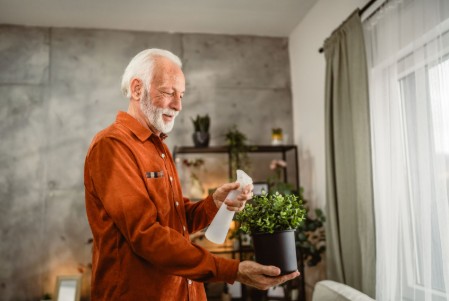Rooting for You: A Guide to Thriving Indoor Plants at The Oaks at Denville
March 14, 2025
Bringing a touch of nature indoors is one of the best ways to create a refreshing, inviting, and vibrant atmosphere. Not only do indoor plants enhance the aesthetics of your home, but they also contribute to better air quality and overall well-being. Whether you’re a seasoned plant parent or just starting your indoor gardening journey, knowing how to care for your plants is key to keeping them healthy and thriving.
At The Oaks at Denville, we understand the joy and benefits of greenery in your living space. This guide will provide you with practical tips to help your indoor plants flourish, making your home even more beautiful and serene.
The Benefits of Indoor Plants
Indoor plants offer much more than just visual appeal—they provide a range of health and wellness benefits that enhance both physical and mental well-being. Research shows that incorporating greenery into your living space can help reduce stress, boost mood, and even improve productivity. Here are just a few of the many advantages:
1. Improved Air Quality
Many houseplants act as natural air purifiers, filtering out harmful toxins while releasing oxygen. Some of the best air-purifying plants include:
- Snake Plant – Removes toxins and thrives in low light.
- Peace Lily – A beautiful, easy-care plant that improves air quality.
- Spider Plant – Helps eliminate pollutants and adds a touch of greenery.
2. Mood-Boosting Properties
Being surrounded by plants has been linked to lower stress levels and improved happiness. Greenery fosters a calming atmosphere, promoting relaxation and mental clarity.
3. Noise Reduction
Plants help absorb sound, making your home feel quieter and more peaceful—especially beneficial in communal living spaces.
4. Humidity Regulation
By releasing moisture into the air, plants help maintain a balanced humidity level, which is beneficial for respiratory health and can prevent dry skin during colder months.
5. Elevating Home Décor
Indoor plants add color, texture, and vibrancy to any space. Whether you prefer a minimalist design or a lush, jungle-like ambiance, there’s a plant to complement your style.
Choosing the Right Indoor Plants
Not all plants thrive indoors, so selecting the right ones is crucial. Here are some of the best low-maintenance indoor plants suited for various lighting conditions:
- Snake Plant (Sansevieria) – Thrives in low light and requires minimal watering.
- Pothos (Epipremnum aureum) – A fast-growing vine that adapts well to different environments.
- Peace Lily (Spathiphyllum) – A stunning air purifier with moderate care needs.
- Spider Plant (Chlorophytum comosum) – Low-maintenance and great for air purification.
- ZZ Plant (Zamioculcas zamiifolia) – Practically indestructible and perfect for low light.
- Aloe Vera – Not only attractive but also useful for skin care and minor burns.
- Fiddle Leaf Fig (Ficus lyrata) – A trendy statement plant that brings elegance to any room.
- Chinese Evergreen (Aglaonema) – Ideal for low-light spaces and available in a variety of colors.
Essential Indoor Plant Care Tips
To keep your plants thriving, follow these essential care guidelines:
1. Provide the Right Light
Different plants have different light requirements. Some flourish in bright, indirect sunlight, while others prefer low-light conditions. Position your plants accordingly:
- Bright, indirect light – Place near a window with filtered sunlight.
- Low light – Ideal for corners or rooms with minimal natural light.
- Signs of trouble – Yellow leaves may indicate too much sun, while droopy leaves may signal insufficient light.
2. Water Wisely
Overwatering is a common mistake. A good rule of thumb:
- Water when the top inch of soil is dry.
- Use pots with drainage holes to prevent root rot.
- Reduce watering during winter when plant growth slows.
3. Maintain Proper Humidity
Indoor environments can become dry, especially in winter. To maintain ideal humidity:
- Mist plants occasionally.
- Use a humidity tray or place a humidifier nearby.
- Group plants together to increase moisture levels naturally.
4. Feed Your Plants
Plants need nutrients to grow strong and healthy.
- Use a balanced liquid fertilizer every few weeks during the growing season.
- Consider slow-release fertilizers for long-term nourishment.
5. Repot When Needed
As plants grow, they may outgrow their pots. Signs that it’s time to repot include:
- Roots growing out of drainage holes.
- Stunted growth.
- Soil drying out too quickly.
6. Watch for Pests
Common indoor plant pests include spider mites, mealybugs, and aphids.
- Inspect leaves regularly for signs of infestation.
- Wipe leaves with a mild soap solution or use insecticidal soap if needed.
- Keep leaves dust-free to prevent pest issues.
Creating a Thriving Indoor Oasis at The Oaks at Denville
With the right care and attention, you can create a lush indoor garden that enhances your home and well-being. At The Oaks at Denville, we celebrate the joys of green living, offering a welcoming environment that supports your love for plants.
Want to learn more about our community? Explore our Community Overview or schedule a visit today. We’d love to show you around!




